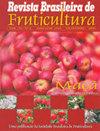Agronomic performance of rootstocks on the juice grape ‘BRS Magna’ grown in a Brazilian semi-arid region
IF 0.9
4区 农林科学
Q4 HORTICULTURE
引用次数: 2
Abstract
Abstract Rootstocks are widely used in viticulture worldwide and can affect the yield components and quality of grapes and their juices and wines. The aim of the present study was to determine the effect of the rootstock on the yield performance and physical and physical-chemical traits of ‘BRS Magna’ juice grapes grown in the Submédio do Vale do São Francisco. The study was performed over six production cycles in the period from 2015 to 2019 in the Bebedouro experimental field of Embrapa Semiárido in Petrolina, PE, Brazil. The treatments consisted of seven grapevine rootstocks: IAC 572, IAC 766, IAC 313, Paulsen 1103, SO4, Harmony, and Freedom. The following variables were evaluated: estimated yield, number of grape bunches per plant, branch and leaf fresh matter, bunch weight, bunch length and width, berry weight, total soluble solids content (SS), titratable acidity (TA), and SS to TA ratio (SS:TA). Significant effects of the rootstock were observed in all the variables except for SS. The rootstock ‘IAC 572’ led to increases of up to 61% in the yield of ‘BRS Magna’ grapevines, or 32.78 ton.ha-1, with significant responses in the other yield components. Results of the scatterplot in relation to the first three principal components allowed separation of the rootstocks in accordance with production cycles. The mean values for SS and TA characterize this cultivar in the Vale do Submédio São Francisco, with high soluble solids content and low acidity resulting in high SS:TA, as having potential for preparation of high quality juices, regardless of the rootstock used.巴西半干旱地区生长的果汁葡萄“BRS Magna”砧木的农艺性能
摘要砧木在世界范围内广泛应用于葡萄栽培,影响着葡萄及其果汁和葡萄酒的产量、成分和品质。本研究的目的是确定砧木对生长在苏马姆萨迪奥do Vale do ss o Francisco的' BRS Magna '果汁葡萄的产量性能和物理和物理化学性状的影响。该研究于2015年至2019年在Embrapa Semiárido位于巴西PE Petrolina的Bebedouro试验田进行了六个生产周期的研究。采用IAC 572、IAC 766、IAC 313、Paulsen 1103、SO4、Harmony和Freedom 7个砧木处理。评估了以下变量:估计产量、每株葡萄串数、枝叶新鲜物质、束重、束长和束宽、浆果重、总可溶性固形物含量(SS)、可滴定酸度(TA)和SS / TA比(SS:TA)。除SS外,砧木对所有变量的影响都很显著。砧木IAC 572使‘BRS Magna’葡萄的产量提高了61%,达到32.78吨。Ha-1,其他产量成分响应显著。根据前三个主成分的散点图结果,可以根据生产周期对砧木进行分离。SS和TA的平均值表明,该品种在弗朗西斯科河谷的可溶性固形物含量高,酸度低,SS:TA含量高,无论使用何种砧木,都有潜力制备高质量的果汁。
本文章由计算机程序翻译,如有差异,请以英文原文为准。
求助全文
约1分钟内获得全文
求助全文
来源期刊
CiteScore
1.50
自引率
20.00%
发文量
34
审稿时长
4-8 weeks
期刊介绍:
The Revista Brasileira de Fruticultura (RBF) publishes technical articles and scientific communications in the area of fruit crops, referring to results of original searches and unpublished papers in Portuguese, Spanish or English, and 1 or 2 reviews per edition, of invited authors.

 求助内容:
求助内容: 应助结果提醒方式:
应助结果提醒方式:


